Alberto (V) d'Este (27 February 1347 – 30 July 1393) was lord of Ferrara and Modena from 1388 until his death.
He was associated in the lordship of the House of Este by his brother Niccolò in 1361, becoming the sole ruler of Ferrara and Modena after the latter's death in 1388. He was the son of Obizzo III d'Este, Marquis of Ferrara, who had ruled in Ferrara from 1317 to 1352.
Alberto founded the University of Ferrara in 1391. In the same year he married Giovanna de' Roberti (d. 1393). After her death, he married his mistress Isotta Albaresani.
He was succeeded by his legitimated son Niccolò (III).

Isotta Albaresani.
Thomas III of Saluzzo (Italian: Tommaso III di Saluzzo) (1356–1416) was Marquess of Saluzzo from 1396 until his death.
He was born in Saluzzo in north-western Italy to Frederick II del Vasto and Beatrice of Geneva. His maternal grandfather was Hugh of Geneva, Lord of Gex, Anthon and Varey.
Alfonso V de Aragón (Medina del Campo, 1396 - Nápoles, 27 de junio de 1458), llamado también el Magnánimo y el Sabio,2entre 1416 y 1458 fue rey de Aragón, de Valencia (Alfonso III), de Mallorca (Alfonso I), de Sicilia (Alfonso I) de Cerdeña (Alfonso II) y conde de Barcelona; y entre 1442 - 1458 rey de Nápoles (Alfonso I).
Era el hijo primogénito del regente de Castilla Fernando de Antequera y posteriormente rey de Aragón con el nombre de Fernando I, y de la condesa Leonor de Alburquerque. Pertenecía, por tanto, a la Casa de Aragón3 por ser nieto de Leonor de Aragón (ya que la dignidad real aragonesa podía transmitirse por línea femenina)4 y al linaje Trastámara por ser nieto de Juan I de Castilla.

Giraldona de Carlino 1359 y 1419 Hija de Enrique Carlino y Isabél Carlino
Bartholomew "Tristan" de Clermont-Lodève (1380 – c. 1432), Count of Copertino, was a French-born knight who married Catherine del Balzo Orsini, youngest daughter ofMary of Enghien and Raimondo del Balzo Orsini, Prince of Taranto. He was the father of Isabella of Clermont, Princess of Taranto, the first consort of King Ferdinand I of Napl
Catherine of Taranto (sometimes Caterina d'Enghien del Balzo Orsini) was the daughter of Mary of Enghien and Raimondo del Balzo Orsini di Nola and sister of Giovanni Antonio del Balzo Orsini.
Giacomo Caracciolo (f. 1499),4 I duque de Caggiano y II conde de Brienza (hijo de Petraccone Caracciolo, I Conde de Brienza, y de su primera esposa Figula Minutolo), y de Lucrezia del Balzo (hija de Jácome del Balzo, conde de Alessano, y de Covella de Tocco)
Guidantonio da Montefeltro (1377 – February 1443) was count of Urbino in Italy from 1403 until his death.
In 1403, at the death of his father Antonio, Guidantonio inherited the family lands in the region of Italy called the Marche. Later he abandoned the Papal suzerainty and allied with King Ladislaus of Naples, who made him Gran conestabile of the Kingdom of Naples in 1411. Excommunicated by Pope Gregory XII, he took advantage of that move to conquer Assisi. He also controlled Castello, Cagli, Forlì, and Forlimpopoli.[1]
Guidantonio later reconciled with Pope Martin V and with his enemy, the condottiero Braccio da Montone. In 1427 he occupied Urbania.
He died in 1443, his son Oddantonio succeeding him in Urbino.
He married Ringarda Malatesta in 1397, but the two had no children. Guidantonio remarried with Caterina Colonna, who bore him 9 children. Apart from Oddantonio, his most famous son was Federico, who was Duke of Urbino, as well as a condottiero and one of the most famous patron of arts in the Italian Renaissance. His daughter Sveva (1434–1478) married Alessandro Sforza, lord of Pesaro.
Alessandro Sforza (21 October 1409 – April 1473) was an Italian condottiero and lord of Pesaro, the first of the Pesaro line of the Sforza family.
He was born in Cotignola in 1409, an illegitimate son of the famous condottiero Muzio Attendolo Sforza.[1]
Jean de Brosse, né en 1375 au château d'Huriel, mort en juin 1433, au château de Boussac, Creuse, seigneur de Boussac(Creuse), Sainte-Sévère (Indre) et Huriel (Allier), maréchal de France. Fils de Pierre de Brosse, seigneur d'Huriel et de Marguerite de Malleval, dame de La Forêt
Jean I de Brosse que les chroniqueurs du temps appelleront « le maréchal de Boussac » (parfois « le maréchal de Sainte-Sévère ») devient un familier de la cour du roi Charles VII. Son ascension à la cour fut probablement facilitée par son cousinage avec la famille de Culant, puis par son union tardive (en 1419, il s'agit sans doute d'un second mariage) avec Jeanne d
Jeanne de Naillac, fille du vicomte de Bridiers, nièce de Philibert de Naillac grand maître des Hospitaliers de Rhodes de 1396 à 1421.
Charles de Châtillon, seigneur d' Avaugour
- Jean I de Châtillon, conde Penthièvre * c. 1340
- Marguerite de Clisson, señora de Champtoceau * c. 1340
Isabeau de Vivonne, dame de Regnac
John II, "The Pious" or "The Babymaker", Duke of Cleves, Count of Mark, (German: Johann II. "der Pious" oder "der Kindermacher", Herzog von Kleve, Graf von Mark) (1458–1521) was a son of John I, Duke of Cleves and Elizabeth of Nevers. He ruled Cleves from 1481 to his death in 1521. He was called "The Babymaker" since he fathered sixty-three illegitimate children [1]before his marriage with Mathilde of Hesse in 1490. She was the daughter of Henry III, Landgrave of Upper Hesse and his wife Anna of Katzenelnbogen.[2]

Mathilde of Hesse (4 July 1473 in Blankenstein – 19 February 1505 in Cologne) was the daughter of Henry III, Landgrave of Upper Hesse (1441-1483) and his wife Anna of Katzenelnbogen (1443-1494).
William IV of Jülich-Berg (9 January 1455 – 6 September 1511) was the last ruler of the Duchy of Jülich-Berg.
William was the son of Gerhard VII, Duke of Jülich-Berg and Sophie of Saxe-Lauenburg. When his father died in 1475, William became Duke of Jülich-Berg.
Sibylle of Brandenburg (31 May 1467 in Ansbach – 9 July 1524 in Kaster) was a Princess of Brandenburg by birth and by marriage Duchess of Jülich and Duchess of Berg.
Sibylle was a daughter of Elector Albrecht III Achilles of Brandenburg (1414–1486) from his second marriage to Anna (1436–1512), daughter of the Elector Frederick II of Saxony.
Phillip II, Count of Nevers (October 1389, Villaines-en-Duesmois – 25 October 1415, Agincourt) was the youngest son of Philip the Bold and Margaret III of Flanders.[1]
Bonne of Artois (1396 – 17 September 1425, Dijon) was the daughter of Philip of Artois, Count of Eu, and Marie, Duchess of Auvergne.

Jacqueline d' Ailly, dame d' Engelmünster
Herman II, llamado "el Sabio", nació en 1345 en el castillo de Grebenstein, era hijo de Luis el Junker quien era un hijo del Landgrave Otón I de Hesse. Fue destinado junto a su hermano Otón a la carrera eclesiástica, estudió en París y en Praga. Después de la muerte de Otón el Joven, el hijo y heredero de Enrique II de Hesse, este último designó a su sobrino Herman como co-regente y heredero en 1367. Dado que había recibido sólo las órdenes menores, pudo sin mucha dificultad salir del clero.
Bernhard VI, Lord of Lippe (c. 1370 – 1415) was a German nobleman. He was the ruling Lord of Lippe from 1410 until his death. He was the son of Simon III and his wife, Irmgard of Hoya.
On 28 June 1393, he married Margaret, the daughter of Count Henry VI of Waldeck-Landau.
Adolf IX., nach anderer Zählung Adolf X. (* um 1375; † 1426) wurde als Sohn von Otto I. von Holstein-Pinneberg und Mechthild von Braunschweig-Lüneburg geboren. Er war verheiratet mit Helene von Hoya. Er regierte Holstein-Pinneberg und die Stammgrafschaft Schauenburg von 1404 bis 1426.
Henry VII of Waldeck (died: after 1442[1]) was Count of Waldeck from 1397 until his death, after which he acted several times asbailiff for the Electorate of Mainz in Upper and Lower Hesse.
He was the second son of the Count Henry VI of Waldeck and Elizabeth of Berg and was considered a belligerent man.
Margaret of Nassau-Wiesbaden-Idstein
Adolph I of Cleves (2 August 1373 – 23 September 1448) was the second Count of Cleves and the fourth Count of Mark.
He was the son of Adolph III, Count of Mark, and Margaret of Jülich (and thus the brother of Margaret of Cleves).

Marie of Burgundy, Duchess of Cleves (1393 – 30 October 1466) was the second child of John the Fearless and Margaret of Bavaria,[1] and an elder sister of Philip the Good.[2] Born in Dijon, she became the second wife of Adolph, Count of Mark in May 1406.[3] He was made the 1st Duke of Cleves in 1417. They were the grandparents of King Louis XII of France and the great-grandparents of John III, Duke of Cleves, father of Anne of Cleves, who was fourth Queen consort of Henry VIII of England. By their daughter, Catherine, they were ancestors of Mary, Queen of Scots.
The Duke and Duchess of Cleves lived at Wijnendale Castle in West Flanders. She died in Cleves in present-day Monterberg,Kalkar.
John II, Count of Nevers (known as Jean de Clamecy, prior to acquiring title of "Count of Nevers"; 1415–1491) was a French noble.
He was the son of Philip II, Count of Nevers by his wife, Bonne of Artois, daughter of Philip of Artois, Count of Eu. John's elder brother, Charles I, Count of Nevers and Rethel, had no legitimate children, and so on his death in 1464 his titles passed to John. In 1472, his uncle Charles of Artois, Count of Eu, died, and having no legitimate children, his title also passed to John.
John fought in the army of his stepfather Philip the Good and was active in Picardy (1434), Calais (1436), Luxembourg (1443), andFlanders (1453). But he clashed with Philip's successor, Charles the Bold, and he defected to King Louis XI of France.
He fought alongside Louis XI in the War of the Public Weal and became Lieutenant General of Normandy.

Louis I of Hesse (German: Ludwig) (6 February 1402, Spangenberg - 17 January 1458), called "the Peaceful" was Landgrave ofLower Hesse (Hesse) from 1413-1458.
He was the son of Hermann II, Landgrave of Hesse and Margaret, the daughter of Frederick V of Nuremberg
Anna of Saxony (5 June 1420 – 17 September 1462, Spangenberg) was a princess of Saxony and by marriage landgravine ofHesse.
Anna was the eldest daughter of the elector Frederick I of Saxony (1370–1428) from his marriage to Catherine (1395–1442), daughter of Duke Henry I "the Wild" of Brunswick-Lüneburg.
Philipp I of Katzenelnbogen (1402–1479), also known "Philipp the Elder" was Count of Katzenelnbogen from 1444 to 1479 and was the last male descendant of the Counts of Katzenelnbogen (his two sons died before him). His parents were Johann IV, Count of Katzenelnbogen (younger line) and Anne of Katzenelnbogen (older line), who merged the two lines of the family back together in 1402.
Philip married on 24 February 1422 in Darmstadt with Anna of Württemberg (1408–1471), daughter of Eberhard IV "the Younger" of Württemberg. In 1456, he obtained from the Pope a divorce a mensa et thoro.
Jacobo I de Baden (15 de marzo de 1407, Hachberg - 13 octubre 1453, Mühlburg), fue Margrave de Baden-Baden desde 1431 a 1453.
Era el hijo mayor de Bernardo I, Margrave de Baden-Baden y Ana de Oettingen. Jacobo era un hombre de profundas creencias religiosas, bien conocido como un fundador de iglesias. Fundó el monasterio de Fremersberg y fue un gran benefactor de la Colegiata de Baden-Baden.
Teodorico de Oldemburgo (en alemán Dietrich von Oldenburg 1390 - 14 de febrero de 1440), apodado el Afortunado, fue un señor feudal alemán, conde de Oldemburgo y Delmenhorst. Fue llamado " Teodorico Fortunato" porque él fue capaz de asegurar Delmenhorstpara su rama de los Oldenburgos.
Teodorico era hijo de Cristián V de Oldenburgo (que se convirtió en conde aproximadamente en 1398 y murió en 1423) y su esposa, la condesa Inés de Honstein (c. 1410/60). Su abuelo, Conrado I de Oldenburgo (m. ca. 1368) había dejado sus tierras divididas entre el padre y el tío de Teodorico, Conrado II.

Heilwig von Holstein (1398-1436), hermana del duque Adolfo VIII de Holstein ambos decendientes de Adolfo I(primer duque de Holstein).
Sigismund I, Prince of Anhalt-Dessau (died Coswig, 19 January 1405), was a German prince of the House of Ascania and ruler of the principality of Anhalt-Zerbst until 1396, when he became the first ruler of the principality of Anhalt-Dessau. He was the eldest son of John II, Prince of Anhalt-Zerbst, by his wife Elisabeth, daughter of John I, Count of Henneberg-Schleusingen.
Albrecht VIII, Graf von Lindow-Ruppin
Anna von Schlesien-Glogau-Sagan
* c. 1410
George of Kunštát and Poděbrady (23 April 1420 – 22 March 1471), also known as Poděbrad or Podiebrad (Czech: Jiří z Poděbrad; German: Georg von Podiebrad), was King of Bohemia (1458–1471). He was leader of the Hussites.
George was the son of Victor of Kunštát and Poděbrady, a Bohemian nobleman, one of the leaders of the Orphans or Utraquists, the more moderate faction of the Hussites during the Hussite Wars. At the age of fourteen, George himself took part in the Battle of Lipany, which marked the downfall of the more radical Taborites.

Kunigunde of Sternberg (Czech: Kunhuta ze Šternberka; 18 November 1425, Konopiště – 19 November 1449, Poděbrady) was the first wife of George of Poděbrady, who later became King of Bohemia. kunigunde's parents were the Bohemian nobles Smil of Sternberg († 1431) and Barbara of Pardubice († 1433). In 1441 she married then 21-year-old George of Poděbrady, who had been captain of the old Bohemian circle of Stará Boleslav[1] since 1440.
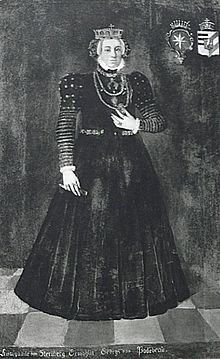
William III (30 April 1425 – 17 September 1482), called the Brave (in German Wilhelm der Tapfere), was landgrave of Thuringia(from 1445) and claimant duke of Luxemburg (from 1457). He is actually the second William to rule Thuringia, and in Luxembourg; he was the third Margrave of Meissen named William. He was a younger son of Frederick I the Warlike, elector of Saxony, and Catherine of Brunswick and Lunenburg
Anne of Bohemia and Austria (12 April 1432 – 13 November 1462) was a Duchess of Luxembourg in her own right, and as consort, Landgravine of Thuringia and of Saxony.
She was the eldest daughter of Albert of Austria, the future Emperor-Elect and Elisabeth, queen of Bohemia, the sole descendant of Sigismund, Holy Roman Emperor.
William (German: Wilhelm) KG (c. 1392 – 1482), called the Victorious, was duke of Brunswick-Lüneburg. He is counted either asWilliam III or William IV.
William was the eldest son of Henry the Mild, Duke of Brunswick-Lüneburg
Count Bodo VII of Stolberg and Wernigerode (also known as Bodo the Elder; born: 1375; died: 15 March 1455 in Stolberg) was a German nobleman. He ruled the counties of Stolberg in the southern Harz and Wernigerode in the northern Harz.
Bodo was the son of Count Henry of Stolberg and Elizabeth née Countess of Hohenstein. Nothing is known about his youth. Perhaps he spent some time at a court of the Counts of Schwarzburg, possibly the one in the Sondershausen.
Anna, the daughter of Count Henry of Schwarzburg

Duke Wartislaw IX of Pomerania-Wolgast (c. 1400 – 17 April 1457, Wolgast) was the eldest son of the Duke Barnim VI, Duke of Pomerania and Veronica. Europaische Stammtafaln does not cite an origin for Veronica.[1]
He reigned from 1417 until his death in 1457 and he married to Sophia of Saxe-Lauenburg-Ratzeburg in 1420 daughter of Eric IV of Saxe-Lauenburg

Bogusław IX; (1407/1410 – 7 December 1446) was a duke of Pomerania in Pomerania-Stolp, whose residence was Stargard. His cousin Eric of Pomerania tried in vain to have him recognized as King of the Kalmar Union.
Bogusław was the son of Bogislaw VIII, Duke of Pomerania, and Sophia of Holstein
Maria of Masovia (pl: Maria mazowiecka; 1408/15 - 14 February 1454), was a Polish princess member of the House of Piast in the Masovian branch.
She was the sixth daughter of Siemowit IV, Duke of Masovia and Alexandra, a daughter of Algirdas, Grand Duke of Lithuania and sister of King Władysław II Jagiełło of Poland.
Eberhard IV of Württemberg (23 August 1388, Stuttgart – 2 July 1419, Waiblingen) was the ruling Count of Württemberg from 1417 until his death.
He was elder son of Count Eberhard III and Antonia Visconti. On 13 November 1397 he became engaged to Henriette of Mömpelgard. Henriette was the oldest daughter and main heiress of Henry of Mömpelgard, who died in 1396 one year before his father, Count Stephan of Mömpelgard. Their marriage, which occurred in 1407 at the latest, caused the county of Mömpelgard to become part of Württemberg. Eberhard IV also had a child with Agnes von Dagersheim.

Henriette (1387 – 14 February 1444) was the daughter of Henry of Orbe (died 1396), and the heiress of her grandfather, Stephen, Count of Montbéliard.[1] Her great-grandfather was Henry I of Montbéliard. She married Eberhard IV, Count of Württemberg and governed the city of Montbéliard together with her husband.
Henry XVI of Bavaria (1386 – 30 July 1450, Landshut), (German: Heinrich der Reiche, Herzog von Bayern-Landshut), since 1393 Duke of Bavaria-Landshut. He was a son of duke Frederick and his wife Maddalena Visconti, a daughter of Bernabò Visconti.

Luis I de Hesse (en alemán: Ludwig) (6 de febrero de 1402, Spangenberg - 17 de enero de 1458), llamado el Pacífico fue Landgrave de Baja Hesse (Hesse) desde 1413 hasta 1458.
Éra hijo de Herman II, Landgrave de Hesse y de Margarita de Hohenzollern-Nuremberg, la hija de Federico V de Nuremberg.
Ana de Sajonia (5 junio de 1420 − 17 septiembre de 1462, Spangenberg) fue una princesa de Sajonia y por matrimonio landgravina de Hesse.
Ana era la hija mayor del elector Federico I de Sajonia (1370-1428) de su matrimonio con Catalina de Brunswick-Lüneburg (1395-1442), hija del Duque Enrique I de Brunswick-Lüneburg.
Federico IV di Norimberga (1287 – 19 maggio 1332) fu Burgravio di Norimberga della dinastia degli Hohenzollern.
Figlio di Federico III e di Elena di Sassonia figlia di Alberto.
Nominato Burgravio di Norimberga alla morte del fratello Giovanni I nel 1300, ottenne anche i burgraviati di Bayreuth e di Ansbach (1331).
Sposò Margherita di Carinzia ed alla sua morte gli succedette il figlio primogenito
Ludovico IV, detto il Bavaro (Monaco di Baviera, 1º aprile 1282 – Fürstenfeldbruck, 11 ottobre 1347), fu duca di Baviera dal 1294,Rex Romanorum dal 1314 e Imperatore del Sacro Romano Impero dal 1328. È sepolto nella Frauenkirche di Monaco di Baviera.
Ludovico era figlio del duca dell'Alta Baviera Ludovico II (il Severo) e di Matilde d'Asburgo.
Beatrice di Slesia-Schweidnitz (1290 circa – Monaco di Baviera, 25 agosto 1322) membro della dinastia polacca di Piast, divenne per matrimonio regina dei romani. Era la figlia secondogenita del duca di Jawor Bolko I e della moglie Beatrice del Brandeburgo (1270 circa - prima del 26 aprile 1316), figlia del Margravio Otto del Brandeburgo (1246circa - 1298)[1]. Fra i fratelli e le sorelle di Beatrice si ricorda Giuditta che divenne la moglie diStefano I di Baviera.
Federico d'Aragona, o Federico III[1] di Sicilia (o di Trinacria) (Barcellona, 13 dicembre 1273 o 1274[3] – Paternò, 25 giugno1337[3]), fu reggente aragonese in Sicilia dal 1291 al 1295, Re di Sicilia - come Federico III[1] - dal 1296 al 1302 e poi di Re di Trinacria dal 1302 alla sua morte. Appare con il nome di Fridericus (rex) nei documenti in lingua latina, Frederic (el de Sicília) in quelli in catalano, Fidiricu in siciliano, Frederico in aragonese.
Figlio maschio terzogenito del re d'Aragona, di Valencia e conte di Barcellona e altre contee catalane, Pietro III il Grande e diCostanza di Sicilia[4], figlia del re di Sicilia Manfredi (figlio illegittimo dell'imperatore Federico II di Svevia e di Bianca Lancia)

Federico d'Aragona, o Federico III[1] di Sicilia (o di Trinacria) (Barcellona, 13 dicembre 1273 o 1274[3] – Paternò, 25 giugno1337[3]), fu reggente aragonese in Sicilia dal 1291 al 1295, Re di Sicilia - come Federico III[1] - dal 1296 al 1302 e poi di Re di Trinacria dal 1302 alla sua morte. Appare con il nome di Fridericus (rex) nei documenti in lingua latina, Frederic (el de Sicília) in quelli in catalano, Fidiricu in siciliano, Frederico in aragonese.
Figlio maschio terzogenito del re d'Aragona, di Valencia e conte di Barcellona e altre contee catalane, Pietro III il Grande e diCostanza di Sicilia[4], figlia del re di Sicilia Manfredi (figlio illegittimo dell'imperatore Federico II di Svevia e di Bianca Lancia)

Eleonora d'Angiò, anche Eleonora di Napoli o Eleonora di Sicilia (Napoli, agosto 1289[1] – Nicolosi, 9 agosto 1341 o 1343), principessa angioina del regno di Napoli, fu regina consorte del Regno di Trinacria dal 1302 al 1337.[2][3][4][5]
Era la decima figlia del re di Napoli e re titolare di Sicilia, conte d'Angiò e del Maine, conte di Provenza e Forcalquier, principe di Taranto, re d'Albania, principe d'Acaia e re titolare di Gerusalemme, Carlo II[6] e di Maria Arpad d'Ungheria, figlia terzogenita di Stefano V d'Ungheria e di sua moglie, la regina Elisabetta dei Cumani[7][8]. Era anche sorella, fra gli altri, di Roberto Duca di Calabria e del minorita San Ludovico da Tolosa.
Stefano Visconti (Milano, 1288 – Milano, 4 luglio 1327), Signore di Arona, era figlio di Matteo I Visconti.
Nel 1318 sposò in seconde nozze Valentina Doria, con la quale ebbe tre figli: Matteo II Visconti, Galeazzo II Visconti e Bernabò, che condivisero il dominio di Milano dopo la sua morte, e una figlia, Grandiana, detta Diana Visconti, sposata intorno al 1333 con Ramon de Vilaragut, Barone diTripi e Signore della Alcaissia e di Sollana, Capitano-Generale e Ammiraglio dell'Armata del Regno di Sicilia, Donzell di Valencia.[1][2]
Presso la Basilica di Sant'Eustorgio a Milano esiste ancora lo splendido monumento funebre scolpito nel 1359 da Bonino da Campione per lui e Valentina Doria Visconti.
Era il figlio di Alboino della Scala e di Beatrice da Correggio. Alla morte di Cangrande I della Scala, lui e suo fratello Alberto II governarono Verona, anche se in realtà il potere era quasi totalmente nelle sue mani. Nella prima parte del suo regno, abbandonando la politica di pace del padre, riuscì a conquistare Brescia (1332), Parma (1335) e Lucca (1335).
Federico II di Meissen, detto il Serio (Gotha, 30 novembre 1310 – Wartburg, 18 novembre 1349), è stato Margravio di Meissen, figlio del Margravio di Federico I di Meissen e di Elisabetta di Lobdeburg-Arnshaugk.
Magnus II di Brunswick-Wolfenbüttel (chiamato anche Magnus con la Collana (latino: Magnus Torquatus); 1324 – 25 luglio1373) fu duca di Brunswick-Lüneburg, governando sui principati di Wolfenbüttel e, temporaneamente, di Lüneburg.
Era figlio di Magnus il Pio, duca di Brunswick-Lüneburg e principe di Wolfenbüttel.
principessa Caterina di Anhalt-Bernburg (1330 circa – 30 gennaio 1390), figlia di Bernardo III; rimasta vedova, essa sposò il nemico di Magnus, il duca Alberto di Sassonia-Wittenberg
Alberto II d'Asburgo, detto il Saggio o lo Sciancato (Castello di Habsburg, 12 dicembre 1298 – Vienna,16 agosto 1358), fu Duca d'Austria e di Carinzia.
Quarto figlio dell'Imperatore Alberto I d'Asburgo e di Elisabetta di Tirolo-Gorizia.

Giovanna di Pfirt, in italiano anche Giovanna di Ferrette (Basilea, 1300 – Vienna, 15 novembre 1351), era la figlia maggiore del conte Ulrico III di Pfirt (1281-1324) e di sua moglie, la principessa Giovanna di Mömpelgard (1284-1349), figlia del conte Reinald di Chalon-sur-Saône e nipote del duca Ugo IV di Borgogna.
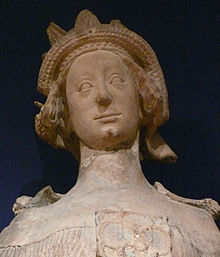
Bernabò Visconti (Milano, 1323 – Trezzo sull'Adda, 19 dicembre 1385) fu Signore di Bergamo, Brescia, Cremona, Soncino, Lonatoe Valcamonica e co-Signore di Milano insieme ai fratelli Matteo II e Galeazzo II. Congiuntamente al fratello Galeazzo, seppur non di comune accordo, estese i domini della famiglia spianando la strada per il grande "Stato Visconteo" che sarebbe stato definitivamente plasmato da suo nipote, Gian Galeazzo Visconti, assurto al potere dopo l'eliminazione di Bernabò. Bernabò nacque a Milano, figlio di Stefano Visconti e di Valentina Doria (figlia di Bernabò Doria, figlio a sua volta di Branca Doria). I dati relativi alla sua infanzia sono scarsi. Nel 1340, con i fratelli Matteo e Galeazzo, si unì alla congiura di Francesco Pusterla contro lo zio Luchino Visconti, allora signore di Milano: la congiura venne sventata e Pusterla eliminato ma Luchino non trovò prove contro i nipoti. Nel 1346 una nuova congiura costò questa volta l'esilio ai figli di Stefano, scacciati da Luchino e dall'arcivescovo Giovanni Visconti, fratello di Luchino. Bernabò ripiegò in Savoia, nelle Fiandre, per finire ospite alla corte di Filippo VI di Francia (1348).
Beatrice Regina della Scala (Verona, 1331 – Sant'Angelo Lodigiano, 18 giugno 1384) fu la primogenita diMastino II della Scala (1308-1351), signore di Verona, Vicenza, Padova, Parma, Brescia e Lucca, e di Taddea di Carrara.
Ebbe tre fratelli, Cangrande II (1332-1359), Cansignorio (1340-1375) e Paolo Alboino (1343-1375), che furono tutti signori di Verona e Vicenza a partire dal 1351 fino al 1375.
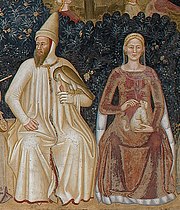
Siemowit III of Masovia (his name also rendered Ziemowit; c. 1320 – 1381) was a prince of Masovia and a co-regent (with his brother Casimir I of Warsaw) of the lands of Warsaw, Czersk, Rawa, Gostynin and other parts of Masovia.
Siemowit was the second son of Trojden I of Masovia and his wife Maria, daughter of Yuri I of Galicia.
Euphemia, daughter of Nicholas II of Opava
Algirdas, in bielorusso Альгерд e in polacco Olgierd (1296 circa – 24 maggio 1377), fu un monarca medievale della Lituania. Egli governò il Granducato di Lituania dal 1345 al 1377, ossia fu sovrano dei lituani e dei ruteni. Con l'aiuto del fratello Kęstutis, che difendeva i confini occidentali del ducato, egli creò un vasto impero che si estendeva dal Baltico fino al Mar Nero, per arrivare a cinquanta miglia da Mosca.
Tra i suoi discendenti si possono annoverare le nobili famiglie dei Trubeckoj, Czartoryski e Sanguszko.
Algirdas fu uno dei sette figli maschi del granduca Gediminas; prima della sua morte, avvenuta nel 1341, Gediminas aveva suddiviso i suoi domini, lasciando al figlio più giovane, Jaunutis, il possesso della capitale Vilnius, con una priorità nominale. Con l'aiuto del fratello Kęstutis, Algirdas riuscì a scacciare l'incapace Jaunutis e si dichiarò esso stesso gran principe nel 1345. Trentadue anni del suo regno, dal 1345 al 1377, furono dedicati allo sviluppo e all'espansione del Granducato di Lituania: Algirdas fu in grado di farne uno dei più importanti stati in Europa ed il più esteso del continente.

Uliana di Tver' (1325 – 1392), al secolo Ul'jana Aleksandrovna Trevskaja (in russo Ульяна Александровна Тверская), fu Granduchessa di Lituania come seconda moglie diAlgirdas.
Figlia del Gran Principe di Tver' Alessandro I e di Anastasia di Galizia, andò in sposa nel 1350 ad Algirdas quando costui si riappacificò con Simeone di Russia sposato con Maria sorella di Uliana.
Vitenis o Viten (bielorruso: Віцень) fue un Gran Duque de Lituania desde ca. 1295 hasta ca. 1316. Fue el primero de losGedimínidas que gobernó durante una período más o menos prolongado. A principios del siglo XIV su reputación eclipsó a la deGediminas, que es considerado por los historiadores como uno de los más grandes gobernantes lituanos.1 El gobierno de Gediminas estuvo marcado por guerras constantes en un esfuerzo por consolidar el Gran Ducado de Lituania entre los rutenos, losmasovios y la Orden teutónica.
 4
4
Miguel Yaroslávich (en ruso, Михаил Ярославич, Mijaíl Yaroslávich) (1271 – 22 de noviembre de 1318), también conocido comoMiguel de Tver, fue un príncipe de Tver (desde 1285) que gobernó como Gran príncipe de Vladímir desde 1304 hasta 1314 y de nuevo desde 1315-1318. Se cuenta entre los santos de la iglesia ortodoxa rusa.
Miguel Yaroslávich fue el segundo hijo de Yaroslav III (Yaroslav Yaroslávich), el hermano menor de Alejandro Nevski) y lo sucedió como Príncipe de Tver en 1285. Su madre, Xenia, era la segunda esposa de Yaroslav III y es conocida como santa Xenia de Tarusa. A la muerte de Andréi Aleksándrovich (hijo de Alejandro Nevski y sobrino de Yaroslav), Miguel se convirtió en el Gran príncipe de Vladímir en 1304, como correspondía con el sistema Rota de sucesión colateral que se había practicado en Rus de Kiev desde los tiempos de Yaroslav I el Sabio. Fue confirmado en el cargo por Toqta, jan de la Horda de Oro.1

Saint Anna of Kashin (Russian: Святая благоверная великая княгиня - инокиня Анна Кашинская) (1280 – 2 October 1368) was a Russian princess from the Rurik Dynasty, who was canonized in 1650.
Anna was a daughter of Prince Dmitry Borisovich of Rostov and a great-granddaughter of Prince Vasily of Rostov. From her earliest years, Anna was brought up strictly Christian. She was taught the virtues of humility and obedience. Her teacher was Saint Ignatius, Bishop of Rostov (d. 1288), who was noted for strict selflessness and pacifism. Like all royal daughters of her time, Anna learned different kinds of needlework. When the princess grew up, Princess Xenia of Tver, second wife of Grand Prince Yaroslav of Tver sent ambassadors to Rostov with a request to marry Anna to her son Mikhail. The embassy was successful, and Anna became the wife of Prince Mikhail.

Alberto II de Austria (12 de diciembre de 1298-16 de agosto de 1358), duque de Austria. Príncipe muy instruido, llamado por ello el Sabio.
Nació en el Castillo de Habsburgo en Habsburgo, hijo de Alberto I, Rey de Romanos, y de Isabel de Tirol. Se convirtió en el gobernante conjunto de todos los territorios de los Habsburgo, con su hermano menor Otón el Alegre en 1330, mientras que aumentó sus posesiones por la herencia de su esposa Juana, que se componía de la Provincia de Pfirt y varias ciudades. Por otra parte, Alberto impuso sus pretensiones de Carintia y Carniola contra Juan I de Bohemia. Como reflejo de su gran reputación entre los mandatarios laicos y la Iglesia de Europa, en 1335 el Papa Benedicto XII le pidió que mediara en el conflicto de la iglesia con el emperador Luis IV de Baviera. Dos años después, en 1337, el rey Felipe VI de Francia le pidió ayuda contra el emperador Luis y el rey Eduardo III de Inglaterra. Sin embargo, Alberto permaneció fiel al emperador hasta la muerte de Luis.

Luis IV de Baviera (1 de abril de 1282 - 11 de octubre de 1347), emperador del Sacro Imperio Romano Germánico entre 1328 y 1347.
Perteneció a la casa de Wittelsbach y era hijo de Luis II, duque de Baviera y de Matilde de Habsburgo, hija de Rodolfo I.

Margarita II de Avesnes , o de Henao, nacida en 1311, muerta en Valenciennes el 30 de septiembre de 1355, fue condesa de Henao desde 1345 a 1355, de Holanda y de Zelanda (bajo el nombre de Margarita I) desde 1345 a 1354. Era hija de Guillermo I, conde de Henao, de Holanda y de Zelanda, y de Juana de Valois

Juan I de Luxemburgo, llamado el Ciego (en francés: Jean L´Auveugle) (1296-1346). Rey de Bohemia (1310-26 de agosto de1346) y Conde de Luxemburgo (1313-1346). Perteneciente a la Casa de Luxemburgo. Hijo del emperador Enrique VII y deMargarita de Brabante, hija de Juan I, duque de Brabante.
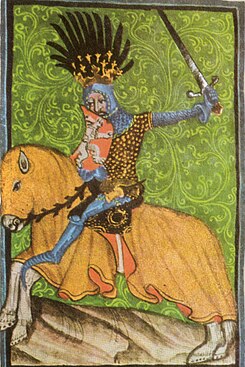
Isabel I de Bohemia (Praga, 20 de enero de 1292 – 28 de septiembre de 1330), reina de Bohemia, hija del Rey Wenceslao II, esposa de Juan I de Luxemburgo y madre del rey de Bohemia y Sacro Emperador Romano Germánico Carlos IV.

Bogislao V (en polaco Bogusław, en latín; Bogislaus, c. 1318 - 23 de abril de 1374) fue un Duque de Pomerania.
Hijo mayor de Vartislaw IV de Pomerania y Elisabeth de Lindow-Ruppin, Bogislao tenía dos hermanos, Barnim IV y Vartislaw V. Los hermanos gobernaron juntos a la muerte de su padre en 1326. Se alió con el rey Casimiro III de Polonia, con cuya hija Isabel de Polonia (1326-1361) se casó Bogislao, en contra de la Orden Teutónica. Isabel murió en 1361, y en 1362 Bogislao se casa nuevamente con Adelaida Welf, hija de Ernesto I de Brunswick-Grubenhagen.
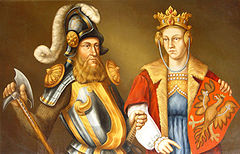
Isabel de Polonia, duquesa de Pomerania (en polaco: Elżbieta Kazimierzówna, 1326-1361) fue la mayor de los hijos deCasimiro III de Polonia y su primera esposa Aldona de Lituania.
Alberto II di Meclemburgo (Schwerin, 1318 – 18 febbraio 1379) fu Duca di Meclemburgo-Schwerin dal1352 sino alla sua morte.
Signore feudale del Nord della Germania, sulle coste del Mar Baltico, resse il titolo di capo della Casa di Meclemburgo, e dagli anni cinquanta del XIII secolo pose la propria sede a Schwerin.
Alberto era il secondo, ma unico sopravvissuto dei figli del Duca Enrico II di Meclemburgo (c. 1266-1329), signore di Stargard (Starij Gorod), dell'antica tribù principesca degli Obotriti, e della sua seconda moglie, la Principessa Anna di Sassonia-Wittenberg (m. 1327), della casata principesca degli Ascanidi.

, Eufemia di Svezia e Norvegia (1317-1370). Suo padre era Eric di Svezia che era Duca di Sudermannia e di Halland, e sua madre era la Principessa Ingeborg di Norvegia, erede e unica figlia legittima del Re Haakon V di Norvegia.
Eric II di Sassonia-Lauenburg (Ratzeburg, 1318/1320 – Ratzeburg, 1386) è stato Duca di Sassonia-Lauenburg.
Eric II era figlio del duca Eric I di Sassonia-Lauenburg e di Elisabetta di Pomerania (1291–dopo il 16 ottobre 1349), figlia di Bogislavo IV di Pomerania. Eric II succedette a suo padre dopo la sua rinuncia al trono nel 1338, come duca di Sassonia-Ratzeburg-Lauenburg, possedimento collaterale del ducato di Sassonia-Lauenburg.
Agnese di Holstein-Plön (?–1386/7), figlia del conte Giovanni III di Holstein-Plön
Magnus II di Brunswick-Wolfenbüttel (chiamato anche Magnus con la Collana (latino: Magnus Torquatus); 1324 – 25 luglio1373) fu duca di Brunswick-Lüneburg, governando sui principati di Wolfenbüttel e, temporaneamente, di Lüneburg.
Era figlio di Magnus il Pio, duca di Brunswick-Lüneburg e principe di Wolfenbüttel.
principessa Caterina di Anhalt-Bernburg (1330 circa – 30 gennaio 1390), figlia di Bernardo III; rimasta vedova, essa sposò il nemico di Magnus
Giovanni II di Norimberga (1309 – 1357) fu burgravio di Norimberga, Bayreuth e Ansbach della dinastia degli Hohenzollern.
Figlio di Federico IV e di Margherita di Carinzia, ottenuti i titoli di burgravio di Norimberga, Bayreuth e Ansbach alla morte del padre, gli succedette l'unico figlio, Federico V.
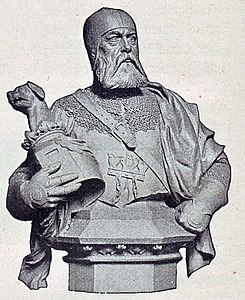
Federico II di Meissen, detto il Serio (Gotha, 30 novembre 1310 – Wartburg, 18 novembre 1349), è stato Margravio di Meissen, figlio del Margravio di Federico I di Meissen e di Elisabetta di Lobdeburg-Arnshaugk.

Era il secondo figlio dell'Imperatore Ludovico IV e di Beatrice di Slesia-Glogau.

Isabella d'Aragona o di Sicilia (1310 – Landshut, 31 marzo 1349) è stata una principessa siciliana appartenente alla dinastia degli Aragona educhessa consorte di Baviera.
Isabella (o Elisabetta) era figlia del re Federico III di Aragona e di Eleonora d'Angiò.
Eric I era figlio di Giovanni I di Sassonia-Lauenburg e di sua moglie, la nobildonna svedese Ingeborg Birgersdotter. Suo padre rinunciò al ducato nel 1282 in favore dei suoi tre figli minori, Alberto III, Eric I e Giovanni II. Ad ogni modo il loro zio Alberto II di Sassonia, mantenne la reggenza dello stato per conto loro sino al 1296. Essi da prima governarono uniti il ducato di Sassonia-Lauenburg, poi lo stato venne suddiviso in tre parti mentre l'exclave Hadeln rimase un co-dominio.
Elisabetta di Pomerania (1291–dopo il 16 ottobre 1349), figlia del duca Bogislavo IV di Pomerania
Magnus I di Brunswick-Wolfenbüttel detto il Pio (1304 circa – 15 giugno o 15 agosto 1369) fu Duca di Brunswick-Lüneburg e principe di Wolfenbüttel.
Figlio di Alberto il Grasso, duca di Brunswick-Lüneburg, era ancora minorenne quando suo padre morì nel 1318. Lui ed il fratello Ernesto vennero quindi affidati alla tutela del fratello maggiore Ottone, che continuò a regnare come unico governante anche dopo che i fratelli raggiunsero l'età adulta.
Sofia (morta nel 1356), figlia del margravio Enrico I di Brandeburgo
Margherita di Baden, figlia del margravio Giacomo I di Baden e di Caterina di Lorena.
Guglielmo III di Sassonia, detto il Valoroso (Meißen, 30 aprile 1425 – Weimar, 17 settembre 1482), era un principe della casa dei Wettin.
Egli era il figlio più giovane del duca e principe elettore di Sassonia Federico I e della di lui consorte principessa Caterina di Braunschweig-Lüneburg, figlia del duca Enrico I di Brunswick-Lüneburg.
Anna d'Asburgo (Vienna, 12 aprile 1432 – Eckartsberga, 13 novembre 1462) era la figlia primogenita del duca d'Austria Alberto V, in seguito divenuto imperatore del Sacro Romano Impero con il nome di Alberto II, e di Elisabetta di Lussemburgo, figlia dell'imperatore Sigismondo e diBarbara di Cilli, e ultima rappresentante dell'estinta Casata di Lussemburgo.
Boghislao X di Pomerania, in tedesco Bogislaw X. o Bogislaw der Große (Boghislao il Grande) (Rügenwalde, 28 o 29 maggio o 3 giugno1454 – Stettino, 5 ottobre 1523), fu un duca tedesco, la cui sovranità si estendeva alla Pomerania; è considerato il più significativo dei duchi del casato dei Greifen in quanto, durante il suo regno, la Pomerania venne riunificata e raggiunse l'apice della sua prosperità.
Era figlio di Eric II di Pomerania-Wolgast e di Sofia, figlia di Boghislao IX, duca di Pomerania-Wolgast-Stolp.
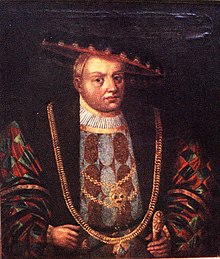
Federico I di Hohenzollern (Norimberga, 21 settembre 1371 – Cadolzburg, 20 settembre 1440) fu l'ultimo burgravio di Norimberga col nome di Federico VI e principe elettore di Brandeburgo col nome di Federico I. Egli era figlio del burgravio Federico V di Norimberga e di Elisabetta di Meissen, e fu il primo membro della casata degli Hohenzollern a regnare sul Brandeburgo.

Elisabetta di Baviera-Landshut (1383 – Ansbach, 13 novembre 1442) fu una principessa bavarese e principessa consorte del Brandeburgo.
Era figlia di Federico di Baviera e di Maddalena Visconti, figlia di Bernabò Visconti, signore di Milano.
Wenceslas I, Duke of Saxe-Wittenberg (c. 1337 – 15 May 1388 in Celle) from the House of Ascania ruled from 1370 to 1388 and was a prince-elector of the Holy Roman Empire as well as Prince of Lüneburg. He was the son of Rudolf I and his 3rd wife, Agnes of Lindow-Ruppin.
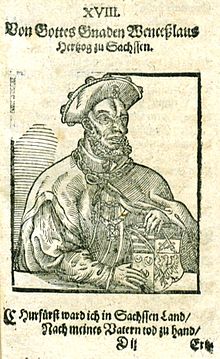
Cecilia of Carrara (d. 1435), daughter of Francis of Carrara (born 29 September 1325 in Padua – died 6 October 1393 in Monza), Count of Padua
Frederick V of Nuremberg (before 3 March 1333 – 21 January 1398) was a Burgrave (Burggraf) of Nuremberg, of the House of Hohenzollern.
He was the elder son of John II of Nuremberg and Elisabeth of Henneberg. From the death of his father in 1357, Frederick bore the title of Burgrave and so was responsible for the protection of the strategically significant imperial castle of Nuremberg. His zeal in the imperial cause led Charles IV to elevate him in 1363 to be the first Burgrave of royal rank.
Elisabeth of Meissen, Burgravine of Nuremberg (22 November 1329 – 21 April 1375) was the daughter of Frederick II, Margrave of Meissen and Mathilde of Bavaria and a member of the House of Wettin.
Frederick (1339 – 4 December 1393) was Duke of Bavaria from 1375. He was the second son of Stephen II and Elizabeth of Sicily.

Adolph II of the Marck (died 19/20 October 1347, Fröndenberg) was Count of the Marck.
He was the eldest son of Engelbert II of the Marck and Mechtild of Arenberg.
Margaret of Cleves, also spelled Margaretha or Margarethe, (c. 1310 – after 1348) was the wife of Count Adolf II of the Marck and mother of Adolf III of the Marck. She was a daughter of Count Dietrich VIII of Cleves and Margaret of Guelders, who was a daughter of Reginald I of Guelders.
John III of Wassenaer, Lord of Polanen (1340 – 10 August 1394) was Lord of Polanen (a heerlijkheid south of Monster). The Lords of Polanen were a branch of the House of Wassenaer. He held extensive possessions besides the fief of Polanen.
He was the eldest son of John II (c. 1324 – 1378), from his first marriage to Oda of Horne (1318-1353). In 1353, his father inherited the extensive possessions of William of Duivenvoorde and in the same year, he purchased the Barony of Breda from the Duke ofBrabant. When John II died in 1378, John III inherited most of these possessions.
John III was married to Countess Oda of Salm-Ravenstein (1370-1428
Frederick III, the Strict (14 December 1332, Dresden – 21 May 1381, Altenburg), Landgrave of Thuringia and Margrave of Meissen, was the son of Frederick II, Margrave of Meissen and Mathilde of Bavaria.

Catherine of Henneberg (German: Katharina von Henneberg ; c. 1334, Schleusingen – 15 July 1397, Meissen) was a Countess of Henneberg by birth and from 1347 by marriage Margravine of Meissen, Landgravine of Thuringia, etc. She was the wife of MargraveFrederick the Severe of Meissen. Via her, the House of Wettin inherited her father's Franconian possessions.
Catherine was the second of four daughters of Count Henry IV of Henneberg-Schleusingen and his wife Judith of Brandenburg-Salzwedel.
Henry of Brunswick-Lüneburg (Latin Henricus, died 14 October 1416), Duke of Brunswick-Lüneburg, called Henry the Mild, was prince of Lüneburg from 1388 to 1409 jointly with his brother Bernard I, Duke of Brunswick-Lüneburg, from 1400 to 1409 also ofWolfenbüttel, and from 1409 until his death sole prince of Lüneburg.
Henry was the fourth son of Magnus with the Necklace, Duke of Brunswick-Lüneburg. He participated in the prosecution of the murderers of his brother Frederick, elected King of the Romans, after 1400. Henry ravaged the Eichsfeld, a possession of thearchbishop of Mainz, who was suspected to be involved in the murder. Only in 1405, a peace was ratified between Brunswick-Lüneburg and the Archbishopric.
Duke John II of Bavaria-Munich (1341 – 1397), (German: Johann II, Herzog von Bayern-München), since 1375 Duke of Bavaria-Munich. He was the third son of Stephen II and Elizabeth of Sicily.
Catherine of Gorizia (died 1391) was a daughter of Count Meinhard VI of Gorizia and his first wife Catherine of Pfannberg.
Albert I of Brunswick-Grubenhagen (c. 1339 – probably 1383) was a Duke of Brunswick-Lüneburg, and Prince of Brunswick-Grubenhagen-Salzderhelden. He reigned from 1361 until his death.
Albert I was the eldest son of the Duke Ernest the elder of Grubenhagen and his wife, Adelheid of Eberstein. In 1359, his father made him co-ruler. After his father's death in 1361, he ruled the principality alone, except for a few possessions at Osterode andHerzberg, which he ceded to his brother Frederick. He lived alone at Salzderhelden Castle in Einbeck, which is why he was nicknamed "Duke of Salt".
Otto the Evil (c. 1330 – 13 December 1394, Hardegsen) was a member of the House of Guelph. He was a Duke of Brunswick-Lüneburg from 1367 Duke in the Principality of Göttingen.
His father was Ernest I (1305–1367), who assumed power in the Principality of Göttingen in 1345. After several years of co-regency in 1367, Otto took up government in this small and economically weak principality. Otto initially resided in the city of Göttingen, where he also held several large jousting tournaments. Over time, however, he had a number of disputes with the citizens of the

Margarete (c.1364 - 18 July 1442), a daughter of Duke William VII of Jülich-Berg
Magnus I, Duke of Mecklenburg (1345 – 1 September 1384) was Duke of Mecklenburg from 1383 until his death. Magnus was the third son of Duke Albert II of Mecklenburg and his wife Euphemia of Sweden, the sister of the King Magnus IV of Sweden. Sometime after 1362, he married Elizabeth of Pomerania-Wolgast, daughter of Barnim IV, Duke of Pomerania.
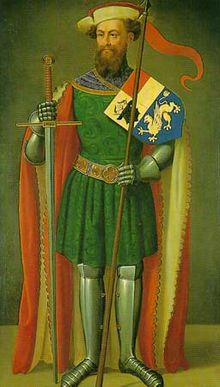
Eric IV of Saxe-Lauenburg (1354 – 21 June 1411 or 1412) was a son of Eric II, Duke of Saxe-Lauenburg and Agnes of Holstein.
Barnim VI, Duke of Pomerania (c. 1365 – 22 September 1405 in Pütnitz, near Ribnitz-Damgarten) was duke of Pomerania-Wolgast from 1394 to 1405. He was the son of Wartislaw VI of Pomerania-Wolgast.

Veronica of Hohenzollern
Eric IV of Saxe-Lauenburg (1354 – 21 June 1411 or 1412) was a son of Eric II, Duke of Saxe-Lauenburg and Agnes of Holstein.
Sophia of Brunswick-Lüneburg (1358–28 May 1416), daughter of Magnus II, Duke of Brunswick-Lüneburg
Bogislaw VIII (c. 1364 – 11 February 1418)[1] was Duke of Pomerania in Pomerania-Stolp from 1395 until 1418. Bogislaw V, Duke of Pomerania
Siemowit IV (Ziemowit IV), also known as Siemowit IV the Younger (pl: Siemowit IV Młodszy; ca. 1353/1356[1] – 21 January 1426[2]), was a Polish prince member of the House of Piast from the Masovian branch, from 1373/74 Duke of Rawa, and after the division of the paternal inheritance between him and his brother in 1381, ruler over Rawa, Płock, Sochaczew, Gostynin, Płońsk and Wizna, since 1386 hereditary Polish vassal, since 1388 ruler over Belz, during 1382-1401 he loss Wizna and during 1384-1399 and 1407-1411 he loss Zawkrze, during 1384-1399 he loss Płońsk, taken by the Teutonic Order.
He was the second son of Siemowit III, Duke of Masovia and his first wife Euphemia, daughter of Nicholas II of Opava.
Alexandra Polish: Aleksandra (died 20 April 1434 in Płock)[1] was the youngest daughter of Algirdas, Grand Duke of Lithuania, and his second wife, Uliana of Tver.[2] Though Alexandra's exact date of birth is not known, it is thought that she was born in the late 1360s or early 1370s. In 1387, she married Siemowit IV, Duke of Masovia, and bore him thirteen children.
Bernard I of Baden (1364 – 5 April 1431, Baden) was Margrave of theMargraviate of Baden from 1391 to 1431.
He was the elder son of Rudolf VI and Matilde of Sponheim. He and his brother Rudolf VII concluded an inheritance contract in 1380, according to which the margraviate might be divided only among male descendants for two generations. Rudolf VII afterwards received the southern areas from Ettlingen via Rastatt to Baden-Baden, Bernard himself the areas around Durlach and Pforzheim.
Anna, daughter of Count Louis XI of Oettingen
Charles II (1364 – 25 January 1431), called the Bold (French: le Hardi) was the Duke of Lorraine from 1390 to his death and Constable of France from 1418 to 1425. [clarification needed] Charles was the elder son of John I, Duke of Lorraine, and Sophie, daughter of Eberhard II, Count of Württemberg.

Margaret of the Palatinate (German: Margarete von der Pfalz; 1376 – 26 August 1434, Einville-au-Jard) was the daughter of Rupert of Germany and his wife Elisabeth of Nuremberg
Engelbert I of Nassau (c. 1370–1380, in Dillenburg – 3 May 1442, in Breda) was a son of Count Johan I of Nassau and Countess Margaretha of the Marck, daughter of Count Adolph II of the Marck.[1]
Johanna van Polanen (also spelled as Jehenne; 10 January 1392 – 15 May 1445 in Breda) was a Dutch noblewoman. She was the daughter of John III of Polanen, Lord of Breda, and his wife, Odilia of Salm.
Jacobo II de Escocia (en escocés medio: Iames Stewart; Palacio de Holyrood, 16 de octubre de 1430 - Castillo de Roxburgo, 3 de agosto de 1460), rey de Escocia desde 1437 hasta su muerte.
Jacobo II fue el hijo de Jacobo I de Escocia y de Joan Beaufort (hija de Juan Beaufort, I conde de Somerset y de Margaret Holland), tuvo un hermano gemelo, Alejandro Estuardo, Duque de Rothesay, quien murió al poco tiempo de nacer.1

María de Güeldres (en inglés, Mary of Guelders, h. 1434 – 1 de diciembrede 1463) fue una reina consorte de Jacobo II de Escocia y regente deEscocia entre 1460 y 1463. Era la hija de Arnold, duque de Güeldres y Catalina, la hija mayor de Adolfo IV, duque de Cléveris.
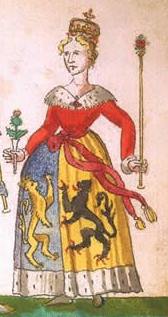
Edmundo Tudor, 1.er Conde de Richmond (c. 1430 – 1 de noviembre de1456) fue el padre del rey Enrique VII de Inglaterra.
Tudor había nacido en Palacio Much Hadham en Hertfordshire o Hadham en Bedfordshire, siendo hijo de Owen Tudor y de Catalina de Valois(anteriormente reina consorte del rey Enrique V de Inglaterra). No se sabe con certeza de sí él al nacer fue legitimado o después de que sus padres estuvieron casados secretamente. En cualquier caso, su madre murió en1437, pero su medio hermano, el rey Enrique VI lo reconoció, nombrándoloConde de Richmond en 1452.
Margarita Beaufort (31 de mayo de 1443 - 29 de junio de 1509) fue la madre del rey Enrique VII y abuela paterna del rey Enrique VIII de Inglaterra. Miembro y apasionada defensora de la casa de Lancaster, se convirtió en una figura clave de la Guerra de las Dos Rosas y en influyente matriarca de la casa de Tudor. Fundó dos colleges de Cambridge. Margarita fue la única hija legítima de Juan Beaufort, duque de Somerset yconde de Kendal, y de Margarita de Beauchamp, heredera de la baronía de Bletsoe. El padre de Margarita era bisnieto del rey Eduardo III a través de su tercer hijo superviviente, Juan de Gante, duque de Lancaster.

Eduardo IV (n. Ruan, Normandía, 28 de abril de 1442 - Westminster,Londres, 9 de abril de 1483) fue Rey de Inglaterra desde el 4 de marzo de1461 hasta el 31 de octubre de 1470, y luego nuevamente desde el 11 de abril de 1471 hasta su muerte en 1483. Fue el primer Rey de Inglaterra de la Casa de York. La primera mitad de su reinado fue perjudicada por la violencia asociada con la Guerra de las Dos Rosas, pero superó el desafío al trono por parte de la Casa de Lancaster durante la Batalla de Tewkesbury en 1471 y luego reinó en paz hasta su muerte súbita. Antes de ser rey, era el IV Duque de York, VII Conde de March, V Conde de Cambridge y IX Conde de Ulster. También era el sexagésimo quintoCaballero del Orden del Toisón de Oro.
Segundo hijo (pero primogénito en la práctica, pues su hermano mayor, Enrique, murió al nacer en 1441) de Ricardo, duque de York y de Cecilia Neville. Fue el rey más importante de la familia de York, durante las guerras de las Dos Rosas.
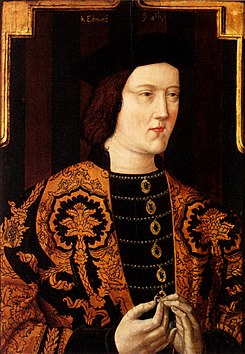
Isabel Woodville (1437 - 7/8 de junio 1492 en Grafton Regis,Northamptonshire, Inglaterra) fue la reina consorte de Eduardo IV de Inglaterra desde 1464 hasta 1483.
Isabel Woodville nació en Grafton Regis como la primera de los doce hijos de un matrimonio desigual. Su padre, sir Ricardo Woodville, chambelán del príncipe Juan de Lancaster, se había casado en secreto con la viuda de su señor, Jacquetta de Luxemburgo, sin el permiso del rey Enrique VI por lo que fueron multados. Sin embargo, su madre mantuvo su rango e ingresos como miembro de la familia real y su padre fue creado barón Rivers en 1448.
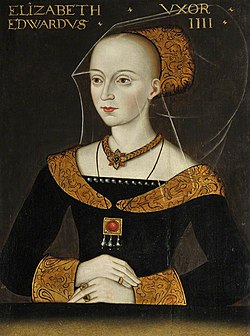
Era hijo de Luis I de Vendôme, miembro de la corte de Carlos VII, mostró su desempeño militar a lo largo de la Guerra de los Cien Años, batallando contra los ingleses en Normandía y Guyena, más tarde fue un fiel soldado de Luis XI de Francia.
Peter II (Pierre de Luxembourg; c. 1440 – 25 October 1482) was Count of Saint-Pol, of Brienne, Marle and Soissons.
In 1478 Peter was made a knight of the Order of the Golden Fleece.
He was the second eldest son of Louis de Luxembourg, Count of Saint-Pol, and Jeanne de Bar, Countess of Marle and Soissons
Margaret of Savoy (April 1439 – 9 March 1483), also known as Marguerite de Savoie or Margherita di Savoia, was the eldest surviving daughter ofLouis, Duke of Savoy. She was the wife of Margrave John IV of Montferrat and later the wife of Pierre II de Luxembourg, Count of Saint-Pol, of Brienne, de Ligny, Marle and Soissons. Margaret's numerous descendants included Mary, Queen of Scots, and King Henry IV of France.
Margaret was born in April 1439 in Turin, Italy, the eldest surviving daughter and one of the nineteen children of Louis, Duke of Savoy (21 February 1402 – 29 January 1465) and Anne de Lusignan, Princess of Cyprus (24 September 1418 – 11 November 1462). Her paternal grandparents wereAmadeus VIII of Savoy, who was also the Antipope Felix V, and Mary of Burgundy, and her maternal grandparents were King Janus de Lusignan of Cyprus and Armenia and Charlotte de Bourbon-La Marche.[1] Her many siblings included Amadeus IX of Savoy, who marriedYolande of Valois, Philip II, Duke of Savoy (5 February 1438 – 7 November 1497), who married firstly Marguerite de Bourbon, and secondly Claude de Brosse, Louis of Savoy, Count of Geneva who married Queen Charlotte of Cyprus (28 June 1444 – 16 July 1487), Charlotte of Savoy, Queen consort of King Louis XI of France, Bona of Savoy, second wife ofGaleazzo Maria Sforza, Duke of Milan, and Marie of Savoy (20 March 1448- 1475), who married, as his second wife, Margaret's father-in-law, Louis of Luxembourg, Count of Saint- Pol, Constable of France.
John Stewart, 1st earl of Atholl
Eleanor Sinclair
Archibald Douglas, 5th Earl of Angus (1449 – October 1513), was a late medieval Scottish magnate. He became known as "Bell the Cat". He became the most powerful nobleman in the realm through a successful rebellion and established his family as the most important in the kingdom.
Angus, born about 1449 at Tantallon Castle in East Lothian, succeeded his father, George Douglas, 4th Earl of Angus, in 1462 or 1463 at the age of just fourteen.
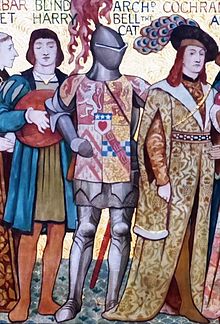
Elizabeth (d. 1498), daughter of Robert Boyd, 1st Lord Boyd
Henry IV, Duke of Mecklenburg (1417 – 9 March 1477) was from 1422 to 1477 Duke of Mecklenburg. Henry IV of Mecklenburg, because of his obesity and lavish lifestyle also called the "Henry the Fat", was the son of the Duke John IVof Mecklenburg and Catherine of Saxe-Lauenburg.

Dorothea of Brandenburg (9 February 1420, Berlin – 19 January 1491, Benedictine monastery at Rehna) was a princess ofBrandenburg by birth and by marriage Duchess of Mecklenburg.
Dorothea was a daughter of the Elector Frederick I of Brandenburg (1371–1440) from his marriage to Elisabeth (1383–1442), daughter of Duke Frederick of Bayern-Landshut. Elizabeth's brothers were Electors Frederick II and Albert Achilles, who successively ruled Brandenburg.
Eric II or Erich II (between 1418 and 1425 – 5 July 1474) was a member of the House of Pomerania (also known as the House of Griffins) and was the ruling Duke of Duke of Pomerania-Wolgast from 1457 to 1474. He was the son of Wartislaw IX of Pomerania-Wolgast and Sophia, daughter of Eric IV of Saxe-Lauenburg.

Sophia of Pomerania-Stolp (1435 – 24 August 1497), was a Duchess of Pomerania by birth, and married to Eric II, Duke of Pomerania.
Sophia was the daughter of Bogislaw IX, Duke of Pomerania and Maria of Masovia. In 1446, her father died and was succeeded by his cousin, Eric of Pomerania, former King of Denmark, Norway and Sweden. Sophia became the heir of Eric of Pomerania's private fortune. In 1451, Sophia was married to Eric of Pomerania-Wolgast, making her spouse the heir of Eric of Pomerania's territories, while Sophia remained the heir of Eric of Pomerania's private fortune. At the death of Eric of Pomerania in 1459, Sophia's husband united Pomerania through the inheritance of Pomerania-Stolp and Pomerania-Rügenwalde by his marriage, while Sophia became the sole possessor of the vast fortune brought by Eric of Pomerania from his former kingdoms's in Scandinavia, as well as the one he had acquired by his piracy activity on Gotland.
Thomas III de Vasto ou Thomas III de Saluces (en italien Tommaso III di Saluzzo), mais aussi Thomas d'Aleran1,2(Saluzzo, 1356 - Saluzzo, 1416) était marquis de Saluzzo, membre de la famille Del Vasto, descendante d'Alérame de Montferrat.
Fils du marquis Federico II del Vasto, il a tenté de poursuivre sa politique pro-française, en particulier contre la menace du duc Amédée VIII, qui aspirait à unifier le Piémont : il décide qu'il est sage de faire allégeance à la France et d'en payer le tribut.
Marguerite de Roucy Marguerite de Pierrepont, fille de Hugues II de Pierrepont comte de Roncy et Braine







Marguerite de Roucy Marguerite de Pierrepont, fille de Hugues II de Pierrepont comte de Roncy et Braine
Bartholomew "Tristan" de Clermont-Lodève (1380 – c. 1432), Count of Copertino, was a French-born knight who married Catherine del Balzo Orsini, youngest daughter ofMary of Enghien and Raimondo del Balzo Orsini, Prince of Taranto.
Teodoro II Paleólogo († 16 de abril de 1418) fue el marqués de Montferrato desde 1381 hasta su muerte.
Fue el tercer hijo de Juan II de Montferrato e Isabel de Mallorca. Teodoro fue nombrado gobernante del marquesado tras la muerte de su hermano Juan III. Tras la muerte de Juan II, Montferrato se vio inmersa en una crisis sucesoria debido a la minoría de edad de sus hijos, que no tenían la suficiente autoridad para imponerse entre ellos ni para poner orden en el caos interno creado en el estado. Los primeros años del mandato de Teodoro estuvieron caracterizados por la regencia de Gian Galeazzo Visconti. Pronto Teodoro dio muestras de tener un carácter débil, y Gian Galeazzo pudo hacer y deshacer a su antojo en Montferrato, obligando a Teodoro a cederle la ciudad de Asti. Teodoro se casó, por su propio deseo, con la hija de Leonardo Malaspina, un súbdito milanés, marqués de Lunigiana y Massa.
Juana de Bar, hija del duque Roberto I de Bar y de María Valois (hija de Juan II de Francia y Bona de Luxemburgo)
Amadeo VII (1360-1 de noviembre de 1391), llamado el Conde Rojo fue conde de Saboya desde 1383 hasta 1391. Era hijo deAmadeo VI de Saboya y Bona de Borbón.
Bona de Berry (1362-1435) hija de Juan I de Berry, Duque de Berry. Se casó con Amadeo VII de Saboya y actuó como regente durante la minoría de edad de su hijo Amadeo VIII de Saboya desde su muerte en 1391. Su hijo se Convertitría en antipapa y por él sería visabuela de Carlota de Saboya, reina de Francia por su matrimonio con Luis XI.
John IV (15 October 1396 – 5 November 1450) was a Count of Armagnac, Fézensac, and Rodez from 1418 to 1450. He was the son of Bernard VII of Armagnac, Count d' Armagnac, of Fézensac, Pardiac, and Rodez; and the brother of Bernard of Armagnac,Count of Pardiac, of La Marche and Duke of Nemours. His mother was Bonne of Berry, niece of Charles V of France.
Isabella of Navarre (1395 – 31 August 1450) was the younger surviving daughter of Charles III of Navarre and his wife Eleanor of Castile. She was a member of the House of Évreux.7
Amadeo VII (1360-1 de noviembre de 1391), llamado el Conde Rojo fue conde de Saboya desde 1383 hasta 1391. Era hijo deAmadeo VI de Saboya y Bona de Borbón.
Bona de Berry (1362-1435) hija de Juan I de Berry, Duque de Berry. Se casó con Amadeo VII de Saboya y actuó como regente durante la minoría de edad de su hijo Amadeo VIII de Saboya desde su muerte en 1391. Su hijo se Convertitría en antipapa y por él sería visabuela de Carlota de Saboya, reina de Francia por su matrimonio con Luis XI.
John IV (15 October 1396 – 5 November 1450) was a Count of Armagnac, Fézensac, and Rodez from 1418 to 1450. He was the son of Bernard VII of Armagnac, Count d' Armagnac, of Fézensac, Pardiac, and Rodez; and the brother of Bernard of Armagnac,Count of Pardiac, of La Marche and Duke of Nemours. His mother was Bonne of Berry, niece of Charles V of France.
Isabella of Navarre (1395 – 31 August 1450) was the younger surviving daughter of Charles III of Navarre and his wife Eleanor of Castile. She was a member of the House of Évreux.7
Antoine of Vaudémont (c. 1400 – 22 March 1458) was Count of Vaudémont and Sieur de Joinville from 1418 to 1458. By marriage, he was also Count of Aumale and Baron of Elbeuf from 1452 to 1458.
His uncle Charles II, Duke of Lorraine had only daughters. Antoine didn't conceal his wish to inherit the Duchy of Lorraine, and quarrelled with Charles. Charles attacked Antoine, but Antoine had Philip the Good of Burgundy as ally.He was the son of Frederick of Lorraine and Margaret of Joinville.

Marie of Harcourt (9 September 1398 – 19 April 1476) was Countess of Aumale and Baroness of Elbeuf from 1452 to 1476. She was the eldest daughter of John VII of Harcourt, Count of Harcourt and Aumale and Baron of Elbeuf, and of Marie of Alençon.
René of Anjou (Occitan: Rainièr d'Anjau; French: René d'Anjou; 1409–1480), also known as René I of Naples (Italian: Renato I di Napoli) and Good King René (Occitan: Rai Rainièr lo Bòn; French: Le bon roi René), was count of Piedmont, duke of Bar (1430–80), duke of Lorraine (1431–53), duke of Anjou, count of Provence (1434–80), king of Naples (1435–42; titular 1442–80), titular king of Jerusalem (1438–80) and Aragon including Sicily, Majorca and Corsica (1466–80).
René was born on January 16[1] or 19,[citation needed] 1409, in the castle of Angers. He was the second son of Duke Louis II of Anjou, King of Sicily (i.e. Naples), by Yolanda of Aragon. René was the brother of Marie of Anjou, who married the future Charles VII and became Queen of France.[1]René of Anjou (Occitan: Rainièr d'Anjau; French: René d'Anjou; 1409–1480), also known as René I of Naples (Italian: Renato I di Napoli) and Good King René (Occitan: Rai Rainièr lo Bòn; French: Le bon roi René), was count of Piedmont, duke of Bar (1430–80), duke of Lorraine (1431–53), duke of Anjou, count of Provence (1434–80), king of Naples (1435–42; titular 1442–80), titular king of Jerusalem (1438–80) and Aragon including Sicily, Majorca and Corsica (1466–80).

Isabella (1400 – 28 February 1453) was suo jure Duchess of Lorraine, from 25 January 1431 to her death in 1453. She was the first wife of Duke René of Anjou, King of Naples, and the mother of his children, which included Margaret of Anjou, Queen consort of England as the wife of Henry VI.
From 1435-42, she was Queen consort of Naples, and from 1442 until her death she was the titular queen consort. During her husband's absences, she acted as regent for his domains.
She was the eldest daughter of Charles II, Duke of Lorraine and Margaret of the Palatinate. Her paternal grandparents were John I, Duke of Lorraine and Sophie of Wurttemberg. Her maternal grandparents were Rupert of Germany and Elisabeth of Nuremberg, daughter of Burgrave Frederick V of Nuremberg and Elisabeth of Meissen.

Riccarda da Saluzzo. Tommaso III de Saluzzo y Margarita de Roussy
Jofré Llançol i Escrivà, (b. c. 1390 - d. c. 1436 or 1437), also known as[1] Jofré de Borja y Escrivà and Jofré de Borja y Doms, was a Spanish noble from Xàtiva, Kingdom of Valencia in the town of Borja, Zaragoza. He was related by marriage to the prestigious House of Borja family. He was the uncle of the cardinal Luis Juan del Milà and father of Pope Alexander VI.
Jofré Llançol i Escrivà was born in Játiva, Comunidad Valenciana around 1390. He was head of the branch of the House of Borja that resided on Ventres Street in Játiva or Xàtiva. He was the son of Rodrigo Gil de Borja y Fennolet, who held the title of Jurado del Estamento Militar de Játiva in 1395, 1406 and 1407, and his wife Sibilia de Escrivà y Pròixita. Jofré died in either 1436 or 1437 in Valencia.[2]
Isabel de Borja y Cavanilles, who was actually his distant cousin, from Valencia. She was the daughter of Domingo de Borja and his wife Francina Llançol one of four children the couple had which also included Alfonso de Borja y Cavanilles who would later go on to become pope Pope Callixtus III and two sisters named Francisca and Catalina.
Luis de Valois o Luis de Orleans (¿?, 13 de marzo de 1372 – París, 23 de noviembre de 1407) fue Duque de Orleans desde el año 1392 a su muerte. También fue Conde de Valois, Duque de Turena (1386 – 1392), Conde de Blois (1397 – 1407), deAngulema (1404 – 1407), de Périgord, de Dreux y de Soissons.
Luis era hijo del rey Carlos V el Noble y de Juana de Borbón, y hermano menor de Carlos VI el Bienamado. En 1389, se casó con su prima hermana Valentina Visconti, hija de Gian Galeazzo, duque de Milán y de su tía Isabel de Valois.

Valentina Visconti (Milán, 1370 - castillo de Blois, 4 de diciembre de 1408) fue hija de Gian Galeazzo Visconti, Duque de Milán y deIsabel de Valois, hija de Juan II de Francia y hermana de Carlos V de Francia.

Ricardo da Bretanha (1395 - 2 de junho de 1438) foi o filho varão mais novo do duque João V da Bretanha e de Joana de Navarra. Foi eleito capitão-geral da Aquitânia e de Poitou, em 1419, e foi feito conde de Étampes em Sablé, em 8 de maio de 1421, confirmado em Poitiers, em outubro de 1425, com o condado de Mantes.

Margarida de Orleães (em francês: Marguerite d'Orléans) (1406 - 24 de abril de 1466) foi filha de Luís, duque de Orleães, e deValentina Visconti. Seu pai foi irmão do rei Carlos V da França; sua mãe foi filha de João Galeácio Visconti, duque de Milão e conde de Pávia, e de Isabel da França, filha do rei João II da França. Foi irmã de Carlos, duque de Orleães, capturado em Azincourt e aprisionado por vinte anos na Inglaterra; durante seu longo cativeiro, ele se tornou o maior poeta quatrocentista em língua francesa.

Gastón IV de Foix (1423-1472) fue conde de Foix y Bigorra y vizconde de Castellbó y Béarn, entre otros títulos que heredó a la muerte de su padre.
Leonor I de Navarra (Olite, 2 de febrero de 1426 - Tudela, 12 de febrero de 1479), fue infanta de Aragón y de Navarra, condesa de Foix por matrimonio (1441-1472), gobernadora (1462–1479) y reina de Navarra (28 de enero-12 de febrero de 1479).
Fue el cuarto hijo y tercera hija de la entonces infanta heredera Blanca de Navarra y de su segundo esposo, el infante Juan de Aragón, duque de Peñafiel.
Jean de Brosse, né en 1375 au château d'Huriel, mort en juin 1433, au château de Boussac, Creuse, seigneur de Boussac(Creuse), Sainte-Sévère (Indre) et Huriel (Allier), maréchal de France. Fils de Pierre de Brosse, seigneur d'Huriel et de Marguerite de Malleval, dame de La Forêt7
Jeanne la jeune, dame de Naillac
Charles de Châtillon seigneur d'Avaugour et d'Isabeau de Vivonne fut vicomtesse de Limoges,comtesse de Penthièvre


Charles de Châtillon seigneur d'Avaugour et d'Isabeau de Vivonne fut vicomtesse de Limoges,comtesse de Penthièvre
Carlos VII de Francia (22 de febrero de 1403-22 de julio de 1461), llamado el Victorioso (en francés: le Victorieux) o el Bien Servido (en francés: le Bien-Servi), fue el quinto hijo del rey Carlos VI y de Isabel de Baviera, descendiente de la dinastía Valois. Se convirtió en heredero al trono y en Delfín de Francia en 1417, coronándose como rey de Francia el 17 de julio de 1429, título que ostentó hasta su muerte en 1461, a pesar de que al inicio de su vida tuvo que disputarse el trono con Enrique VI de Inglaterra, cuyo regente, el Duque de Bedford, dominaba gran parte del Reino de Francia, incluyendo la capital, París.
Fue hijo de Carlos VI, Rey de Francia, pero su sucesión al trono fue puesta en tela de juicio por los ingleses que ocupaban el norte de Francia, y el Tratado de Troyes, firmado por su padre, Carlos VI, que estipulaba que el sucesor al trono francés seríaEnrique VI, el monarca inglés. Aun así, fue coronado en Reims en 1429 gracias en parte a los esfuerzos de Juana de Arco por liberar Francia de la ocupación inglesa. La última fase de su reinado se caracterizó por fricciones constantes con su hijo, el futuro Luis XI.
Nacido en París en 1403, Carlos fue el quinto hijo de Carlos VI y de Isabel de Baviera; tenía cuatro hermanos mayores, Carlos (1386), Carlos (1392-1401), Luis (1397-1415) y Juan (1398-1417), cada uno ostentó el título de Delfín de Francia, heredero al trono francés. Sin embargo, todos murieron siendo niños, dejando a Carlos una herencia rica en títulos.

Agnès Sorel (14221 2 - 9 de febrero de 1450), conocida por el apodo Dame de beauté, fue la amante favorita del rey Carlos VII de Francia, con quien tuvo tres hijas. Es considerada la primera amante real reconocida de manera oficial.1
Fue el sujeto de numerosas obras de arte contemporáneas, incluyendo la célebre obra de Jean Fouquet La virgen con el niño.
Hija del soldado Jean Soreau y de Catherine de Maignelais, Sorel tenía veinte años de edad cuando fue presentada por primera vez al rey Carlos. En ese momento, ocupaba una posición en la residencia de Renato I de Nápoles, como dama de compañía de su consorte Isabel de Lorena. Más tarde, comenzó a servir a María de Anjou, la esposa de Carlos VII, de quien se convertiría en amante poco tiempo después.1 El rey le dio el Castillo de Loches (donde Juana de Arco lo había convencido de coronarse rey de Francia) para que fuera su residencia privada.3

Aymar DE POITIERS
- Décédé après 9 septembre 1510 Jeanne DE LA TOUR D'AUVERGNE
- Bertrand VI DE LA TOUR D'AUVERGNE, Comte D'AUVERGNE 1417-1497
- Louise DE LA TRÉMOÏLLE 1432-147
- Imbert de Batarnay (prénom et nom sont parfois orthographiés Ymbert ou Humbert et Bastarnay), également connu comme « Monsieur du Bouchage » du nom de l'un de ses nombreux domaines, dans le Dauphiné, est un homme d'Étatfrançais du Moyen Âge tardif et de la Renaissance. Il est né vers 1438, probablement à Bathernay dans la Drôme, et mort le à Montrésor (Indre-et-Loire).
- Issu d'une famille de la petite noblesse dauphinoise dont le premier membre connu est Girard de Batarnay, vivant au milieu du xiiie siècleMt 1, Imbert de Batarnay naît vers 1438, probablement au château de Bathernay (Drôme), d'Arthaud de Batarnay et de Catherine de GasteMR 1 ; il compte au moins dix frères et sœursDx
- Georgette de Montchenu ç
- Alano de Albret, llamado el Grande ( 1440- 1522), fue el XVI señor de Albret, vizconde de Tartas, II conde de Graves y conde de Castres, un noble francés con una destacada presencia en el panorama político y militar de dicho país durante el siglo XV.
Alano de Albret era hijo de Juan I de Albret y Catalina de Rohan. En tanto que nieto y heredero de Carlos II de Albret pasó a ser el jefe de la Casa de Albret en 1471.
No hay comentarios:
Publicar un comentario